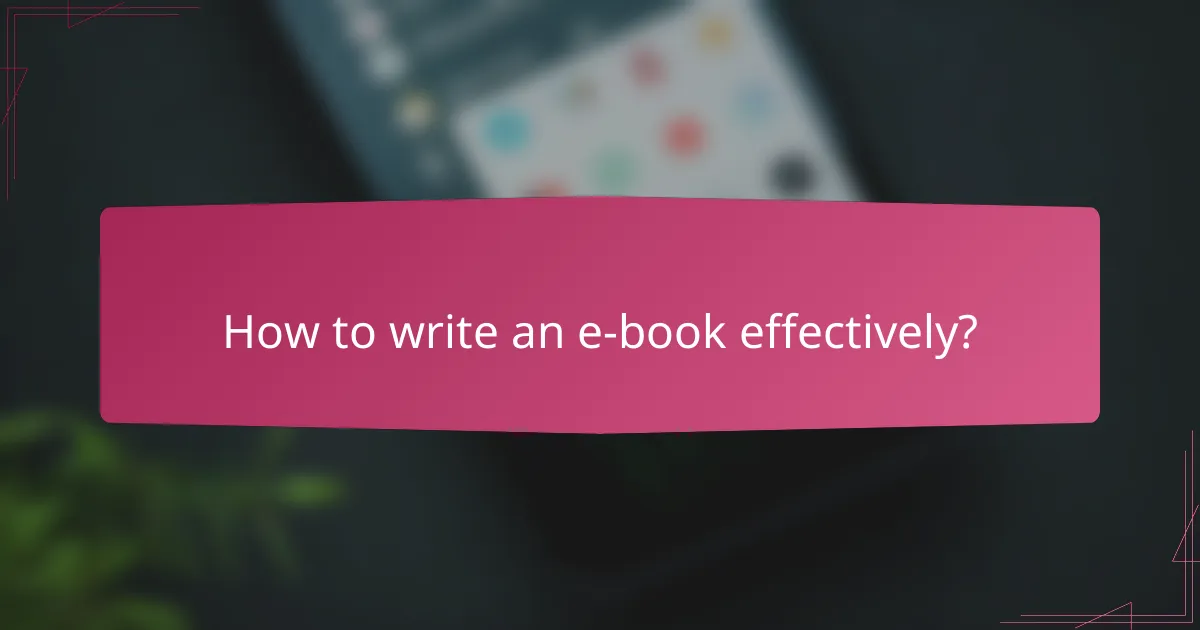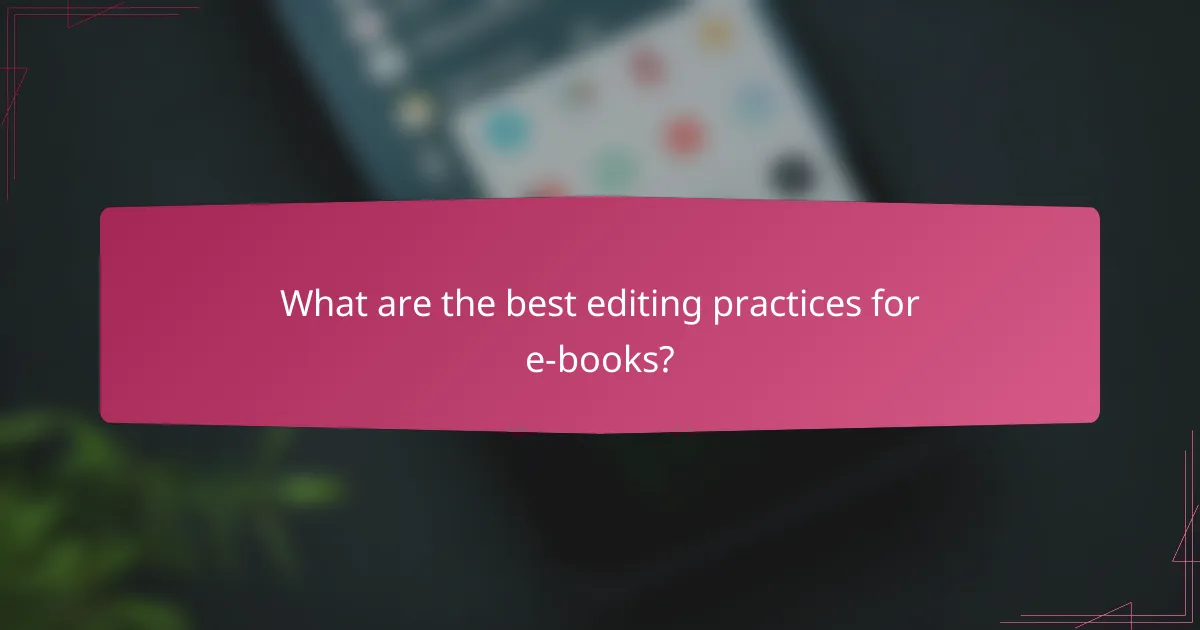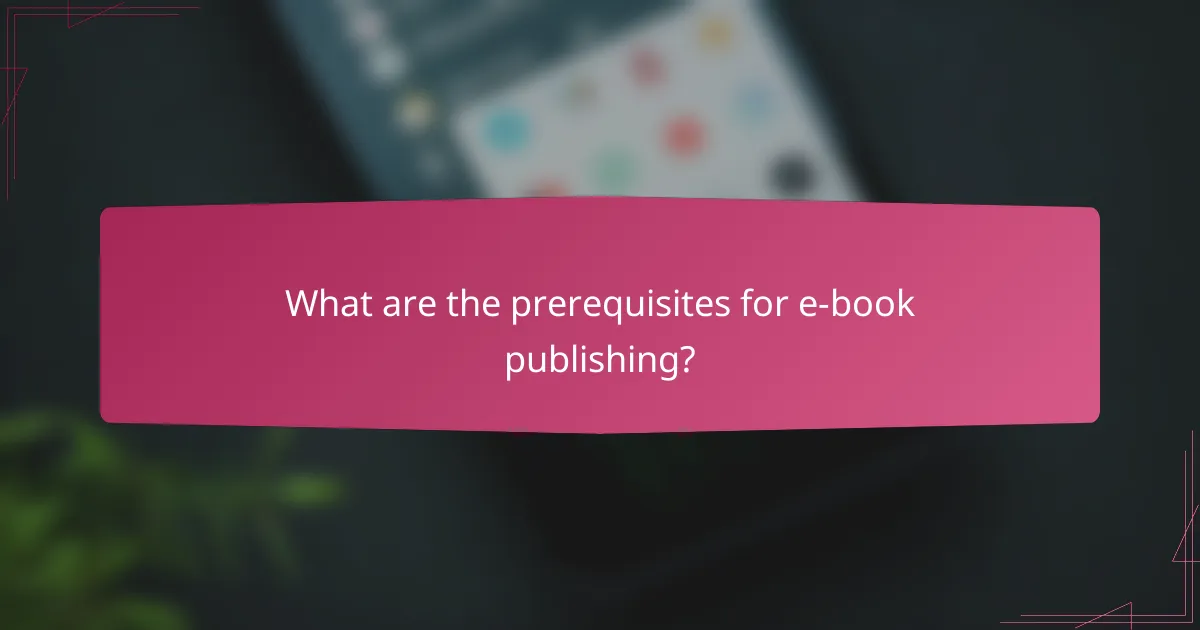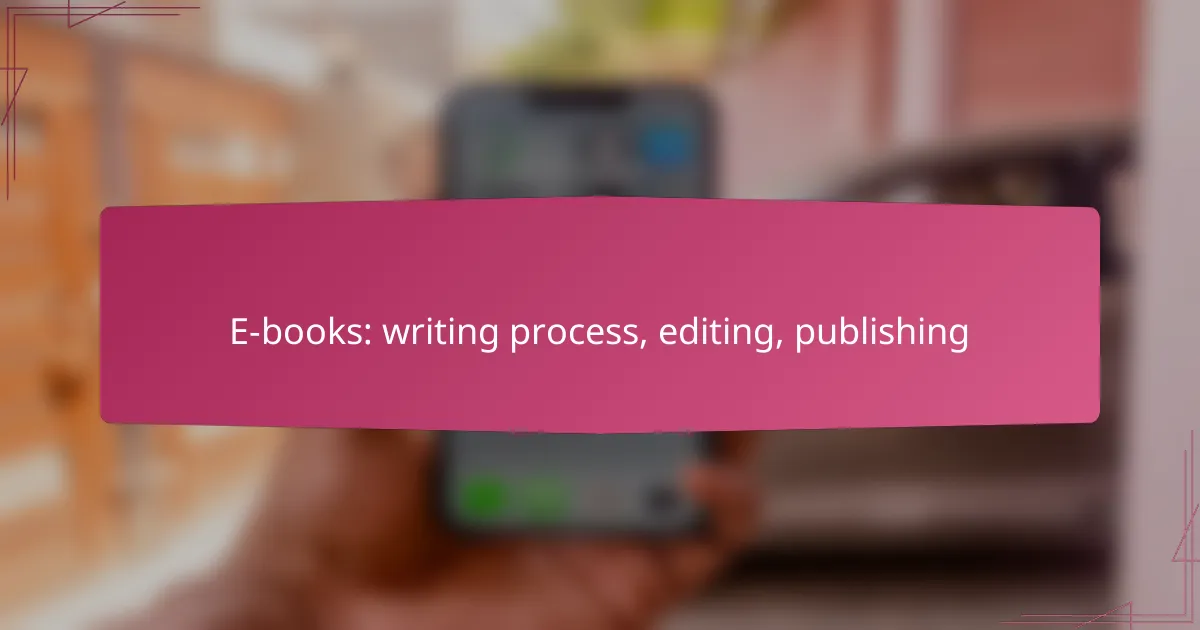Creating an e-book involves a structured approach that includes planning, writing, and editing to ensure a high-quality final product. By understanding your audience and employing effective editing techniques, you can enhance your content’s clarity and engagement. Additionally, navigating the publishing process with attention to platform selection and marketing strategies is essential for reaching your readers successfully.

How to write an e-book effectively?
Writing an e-book effectively involves a clear plan, the right tools, and a consistent writing routine. By focusing on your audience and incorporating engaging storytelling, you can create a compelling e-book that resonates with readers.
Outlining your e-book structure
Start by creating a detailed outline that organizes your main ideas and chapters. This structure serves as a roadmap, helping you maintain focus and coherence throughout the writing process. Consider using bullet points or numbered lists to break down each chapter into key sections.
For example, if your e-book is about digital marketing, your outline might include chapters on SEO, content marketing, and social media strategies. Each chapter can then be subdivided into specific topics, ensuring comprehensive coverage.
Choosing the right writing tools
Selecting the right writing tools is crucial for a smooth writing experience. Popular options include word processors like Microsoft Word or Google Docs, which offer collaborative features and easy formatting. Additionally, consider using specialized e-book writing software like Scrivener for more complex projects.
Evaluate tools based on your needs; for instance, if you prefer cloud access and collaboration, Google Docs might be ideal. If you need advanced organizational features, Scrivener could be the better choice.
Establishing a writing routine
Creating a consistent writing routine helps you stay productive and motivated. Set aside specific times each day or week dedicated solely to writing, aiming for a balance that fits your lifestyle. Many writers find success with daily word count goals, ranging from 500 to 2,000 words.
To maintain momentum, consider using techniques like the Pomodoro Technique, which involves writing for 25 minutes followed by a 5-minute break. This can enhance focus and reduce burnout.
Identifying your target audience
Understanding your target audience is essential for crafting relevant content. Research demographics, interests, and pain points to tailor your e-book to their needs. Create reader personas to visualize your audience and guide your writing style and tone.
For instance, if your e-book targets young entrepreneurs, use a conversational tone and include practical examples that resonate with their experiences. This approach increases engagement and makes your content more relatable.
Incorporating engaging storytelling techniques
Using storytelling techniques can enhance the appeal of your e-book. Incorporate anecdotes, case studies, or relatable scenarios to illustrate your points and keep readers invested. This not only makes your content more enjoyable but also helps convey complex ideas effectively.
Consider using the “show, don’t tell” approach by painting vivid pictures with your words. For example, instead of stating facts about marketing strategies, share a story about a business that successfully implemented those strategies and the results they achieved.

What are the best editing practices for e-books?
The best editing practices for e-books involve a combination of self-editing, utilizing software tools, hiring professionals, and engaging in peer reviews. Each method contributes to refining content, enhancing clarity, and ensuring a polished final product.
Self-editing techniques
Self-editing is a crucial first step in the editing process. Start by taking a break after writing to gain fresh perspective, then read your work aloud to catch awkward phrasing and errors. Focus on structure, clarity, and consistency throughout your manuscript.
Consider creating a checklist that includes common issues like passive voice, overused words, and punctuation errors. This can help streamline your editing process and ensure you address key areas effectively.
Using editing software like Grammarly
Editing software, such as Grammarly, can significantly enhance your editing efforts by providing real-time feedback on grammar, punctuation, and style. These tools often highlight potential issues and suggest improvements, making it easier to refine your writing.
While software can catch many mistakes, it’s essential to remember that it may not understand context or nuance. Always review suggestions critically to ensure they align with your intended message.
Hiring professional editors
Hiring a professional editor can elevate your e-book by providing expert insights and a fresh perspective. Look for editors with experience in your genre, as they will be familiar with industry standards and reader expectations.
When selecting an editor, consider their editing style and whether it aligns with your vision. Be prepared to invest a portion of your budget, as professional editing can range from a few hundred to several thousand dollars, depending on the length and complexity of your work.
Peer review strategies
Engaging in peer reviews can provide valuable feedback from fellow writers or readers. Consider forming a writing group where members can exchange manuscripts and offer constructive criticism on each other’s work.
When conducting peer reviews, establish clear guidelines for feedback to ensure it is specific and actionable. Focus on elements like plot coherence, character development, and overall readability to help each other improve your e-books effectively.

How to publish an e-book successfully?
To publish an e-book successfully, focus on selecting the right platform, understanding formatting requirements, setting a competitive price, and creating a solid marketing plan. Each step is crucial to ensure your e-book reaches its intended audience effectively.
Choosing the right publishing platform
Selecting the right publishing platform is essential for your e-book’s visibility and sales. Popular options include Amazon Kindle Direct Publishing (KDP), Apple Books, and Smashwords, each with unique features and audience reach.
Consider factors such as royalty rates, distribution channels, and ease of use when making your choice. For instance, KDP offers up to 70% royalties for e-books priced between $2.99 and $9.99, making it a lucrative option for many authors.
Understanding e-book formatting requirements
Proper formatting is vital for ensuring your e-book looks professional across different devices. Common formats include EPUB, MOBI, and PDF, each with specific requirements regarding layout, font, and images.
Use tools like Calibre or Scrivener to convert your manuscript into the desired format. Pay attention to guidelines provided by your chosen platform to avoid issues during the upload process.
Setting the right pricing strategy
Establishing a competitive pricing strategy can significantly impact your e-book’s sales. Research similar titles in your genre to determine a suitable price range, typically between $0.99 and $9.99 for most e-books.
Consider offering promotional pricing or discounts during the launch phase to attract initial readers. Monitor sales data to adjust your pricing strategy as needed for optimal results.
Creating an effective marketing plan
An effective marketing plan is crucial for promoting your e-book and reaching potential readers. Utilize social media platforms, author websites, and email newsletters to create buzz around your release.
Engage with your audience through book trailers, blog posts, and virtual book tours. Collaborating with influencers or bloggers in your genre can also enhance your visibility and drive sales.

What are the prerequisites for e-book publishing?
Before publishing an e-book, you need to understand copyright laws, obtain an ISBN, and establish an author platform. These elements are crucial for protecting your work, ensuring discoverability, and building a reader base.
Understanding copyright and ISBNs
Copyright protects your e-book from unauthorized use and reproduction. You automatically hold copyright upon creation, but registering it can provide additional legal benefits, especially if disputes arise.
An ISBN (International Standard Book Number) is essential for e-books as it helps retailers and libraries identify your book. Obtaining an ISBN can cost around $125 in the U.S. for a single number, but bulk purchases are available at a lower per-unit price.
Building an author platform
Creating an author platform involves establishing a presence online to connect with potential readers. This can include a website, social media profiles, and an email newsletter to share updates and engage with your audience.
Focus on providing valuable content related to your writing niche, such as blog posts or free resources. Consistency in your messaging and engagement can significantly enhance your visibility and credibility as an author.

How to market your e-book in the digital landscape?
To effectively market your e-book in the digital landscape, leverage online platforms and tools that reach your target audience. Focus on building a strong online presence and engaging with potential readers through various channels.
Utilizing social media for promotion
Social media is a powerful tool for promoting your e-book, allowing you to connect with a broad audience. Platforms like Facebook, Twitter, Instagram, and LinkedIn can help you share updates, engage with readers, and build a community around your work.
Consider creating dedicated pages or profiles for your e-book where you can post content related to its themes, share behind-the-scenes insights, and run promotional campaigns. Use eye-catching visuals and compelling captions to attract attention and encourage shares.
Engage with your audience by responding to comments and messages promptly. Running contests or giveaways can also boost visibility and encourage followers to spread the word about your e-book.
